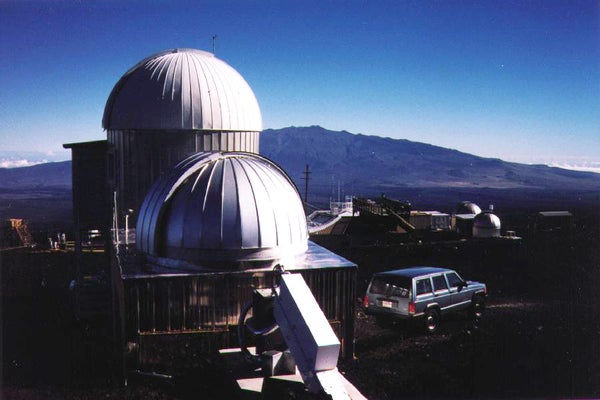The amount of carbon dioxide in the atmosphere has increased at an unprecedented pace in the last two years, even as Trump administration officials discount the relevance of a number that many climate scientists find deeply disturbing.
The CO2 measured at the Mauna Loa Baseline Atmospheric Observatory in Hawaii hit 405.1 parts per million last year, the National Oceanic and Atmospheric Administration announced. That’s an increase of 3 parts per million, which matched the record of 3 parts per million in 2015. It marks five consecutive years of CO2 increases of at least 2 parts per million, an unprecedented rate of growth, said Pieter Tans, lead scientist at NOAA’s Global Greenhouse Gas Reference Network.
“The rate of CO2 growth over the last decade is 100 to 200 times faster than what the Earth experienced during the transition from the last ice age,” Tans said. “This is a real shock to the atmosphere.”
On supporting science journalism
If you're enjoying this article, consider supporting our award-winning journalism by subscribing. By purchasing a subscription you are helping to ensure the future of impactful stories about the discoveries and ideas shaping our world today.
The number is significant because the amount of carbon dioxide in the atmosphere was 280 parts per million from about 10,000 years ago until the start of the Industrial Revolution. The monthly global average nosed above 400 parts per million for the first time in March 2015 and is now increasing at a faster pace, according to NOAA researchers. What’s more, carbon emissions stay in the atmosphere for years, so even as some emissions have been reduced in recent years, the global average level continues to climb. In 1960, they were about 300 parts per million, suggesting a precipitous climb in a relatively short period of time since then.
That means carbon dioxide levels have dramatically increased by more than 40 percent in the lifetime of many people on Earth, said Ralph Keeling, director of the Scripps CO2 Program and a greenhouse gas expert. Keeling, whose father, Charles David Keeling, pioneered modern carbon measurement systems, said the carbon dioxide levels will continue to stay high as fossil fuel burning increases, and that they could hit 410 parts per million this year or next.
“As we twiddle our thumbs, CO2 just keeps going up and up; it’s a lot of carbon dioxide compared to what the atmosphere has had in it over many, many thousands of years or even hundreds of thousands of years,” he said.
The high rate of increase in CO2 levels was also observed at 40 other facilities in NOAA’s Global Greenhouse Gas Reference Network. The CO2 levels trap heat in the atmosphere and in the oceans, causing sea levels to rise, spurring drought in spots across the globe and increasing extreme weather, among many other effects observed by scientists.
Scientists: Yes, Mr. Pruitt, CO2 is the primary contributor to warming
For about two decades, climate scientists have agreed that the amount of carbon dioxide being pumped into the atmosphere by humanity, chiefly from the burning of fossil fuels, is causing the planet to warm at a rapid pace, Keeling said. The Mauna Loa results mark a troubling trend, as CO2 emissions continue at a record pace even as coal emissions in China decline and renewable energy use is increasing around the globe.
U.S. EPA Administrator Scott Pruitt angered many researchers and environmental groups last week when he falsely claimed that humans are not the primary contributor to climate change.
Pruitt’s comments also included his assertion that Congress should decide whether EPA should even regulate carbon dioxide.
“I think that measuring with precision human activity on the climate is something very challenging to do, and there’s tremendous disagreement about the degree of impact, so no, I would not agree that it’s a primary contributor to the global warming that we see,” he said on CNBC’s “Squawk Box.”
Pruitt’s comments were one of the most direct indications yet that the Trump administration will ignore the federal climate scientists warning it about data points such as the rate of CO2 growth observed on Hawaii.
Yesterday, a group of more than two dozen climate scientists sent Pruitt a letter criticizing his comments and pointing out that most climate warming over the last few years is due to increasing carbon dioxide levels as well as other greenhouse gases. The scientists, who included researchers from Harvard University, Stanford University and the Massachusetts Institute of Technology, among others, pointed out that humans have increased carbon dioxide levels by 40 percent and that CO2 is continuing to drive warming.
“We know that if we continue to increase the atmospheric levels of greenhouse gases, the Earth will continue to heat up, with serious consequences for economies and ecosystems across the globe,” they wrote.
Pruitt’s comments also alarmed American Meteorological Society Executive Director Keith Seitter, who also sent Pruitt a letter yesterday noting that thousands of independent scientists and numerous scientific institutions around the world have concluded that humans are driving the carbon dioxide levels now warming the world. Seitter said he does not know of any scientific institution that has reached a different conclusion.
“We understand and accept that individuals and institutions both public and private can reach differing conclusions on the decisions and actions to be taken in the face of this reality,” he wrote. “That’s the nature of the political process in a democratic society. But mischaracterizing the science is not the best starting point for a constructive dialogue.”
Reprinted from Climatewire with permission from E&E News. E&E provides daily coverage of essential energy and environmental news at www.eenews.net.
